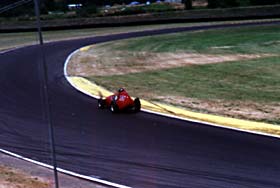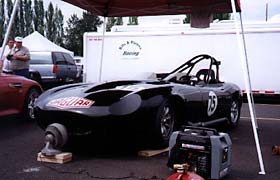The need for speed is deeply embedded in the human psyche. In some humans, for sure. I don't have a good explanation for this, as humans are not inherently speedy creatures. I'm sure that when Bogg the Cro-Magnon spooked an antelope he and his buddies were stalking and got called "stupid Australopithecene," he replied, "Screw dinner -- I just wanted to see that sucker haul rump steaks, ya know?"
One thing leads to another. Guys who were good at chipping off sharp stone flakes began inventing more complicated machines, finally becoming what we call engineers. Running on foot was replaced by riding on horses, and eventually driving in cars the engineers built. Today, we pretty much take both engineers and cars for granted, for good or ill.
Some engineers -- probably Bogg's descendants -- built cars that were useless for doing anything except hauling rump. We call these racecars. Initially, racecars served as a form of advertising. A manufacturer whose racecars could reliably go far and fast must be building similar virtues into its touring cars,  and the small portion of the public able to afford cars at all would understand that and favor the winning marque, right? Not a bad excuse.
and the small portion of the public able to afford cars at all would understand that and favor the winning marque, right? Not a bad excuse.
In the conflicted years between the two World Wars, European racing took on nationalist overtones. When Nuvolari defeated a well-funded team of new Mercedes "über-racers" in an outdated Alfa, all Italy triumphed (it didn't hurt that the Alfa team was managed by a young Enzo Ferrari, from whom we'd hear more later). Italians remember Nuvolari today much as Americans remember Jesse Owen's performance at the 1936 Olympic games in Berlin, and for much the same reasons.
European production cars increasingly took on distinctive characteristics by country of origin -- German engineering was quite different from British, which was different from Italian, which was nothing like French (nothing is, actually). Almost every manufacturer built special high-performance models, often toned-down versions of its racecars, which competed largely on public roads in the first place. We call these sports cars.
In the United States during that period, auto racing had become more of a carnival event. The depression had mostly killed off high-end, expensive performers like Deusenberg and Maxwell, and racecars were for the most part stripped-down units based on Fords or Chevrolets. Contests took place on oval tracks (dirt, paved or even wood) where the public could see the whole course at once. The public was primarily interested in buying inexpensive, utilitarian family cars, and the relationship between racing success and sales was lost. In the post-war prosperity boom, there were no American sports cars -- we simply didn't have the concept. The Corvette was just a two-seat version of Chevy's family cars with a fiberglass body, mechanically unremarkable, and as poor a seller as it was a performer. Racing continued on oval tracks, and "real" racecars (as in "Indianapolis 500") had little to do with production models or companies selling cars to the public. (Kids were transforming old jalopies into hot rods, giving them improved straight-line performance and inventing drag racing -- but that's a different matter entirely.)
European sports cars slowly infiltrated the U.S. regardless. It began with returning servicemen bringing back spindly MGs, which were as out of place on American roads as gerbils in a herd of sea elephants. Their only appeal was that they were fun to drive fast (or as fast as they'd go, anyway -- no one could consider an MG-TC remotely related to a rocket), a feature utterly lacking in American cars of the day. Other British, German and Italian models followed in small numbers. A spontaneous camaraderie arose amongst owners of these oddities: if you encountered one going the other way, you waved at it; if going the same way, you raced it.
As the popularity of sports cars increased (albeit they remained minuscule as a market segment), regional clubs took form for the purpose of holding organized sports car races, sometimes on regular roadways they'd arrange to have cleared of normal traffic for a few hours. The local residents took note. The press took note. The manufacturers took note and began sending special racing models and drivers to participate. The resulting mix of professionally-driven 160 MPH Jaguars and Ferraris running with  self-taught drivers in 70 MPH MGs on tree- and crowd-lined roadways took a toll in fatalities -- but the sports car bug had bitten; this form of racing simply refused to be deported back to Europe.
self-taught drivers in 70 MPH MGs on tree- and crowd-lined roadways took a toll in fatalities -- but the sports car bug had bitten; this form of racing simply refused to be deported back to Europe.
Over the next decade, sports car racing moved onto real race tracks, driver licensing became a requirement, cars were sorted into sensible groups, and safety standards were implemented under the auspices of the Sports Car Club of America (SCCA). This continues today -- despite the death of the "true" sports car circa 1970 due to manufacturing economics versus Federal smog and safety standards. Some sports-like cars hung on, but the golden era had ended.
Vintage racing -- also called historic racing -- is a return to that bygone age. There are cars that were actually raced pre-1970 (famous or not), and street sports cars of the era that have been modified for racing much as cars of the time would have been. The gamut runs from one-of-a-kind 1930s factory team racers worth hundreds of thousands of dollars to beat-up Austin Minis with few mods beyond roll cages and racing harnesses. Elements of both history and nostalgia are involved, but mostly, it's a bunch of people with a passion for racing and older cars determined to keep them doing what they were made to do: being fun to drive as fast as they can be made to go. The camaraderie is palpable and the paddocks are generally open to spectators. Owners are proud of their cars and are usually happy to show them off to anyone who takes an interest.
The various vintage racing associations have their own methods of grouping cars, but there are two sorts of races (to my mind). The first is more exhibition than competition, as the group is comprised of cars that would never have run together when new, but that simply don't fit into more evenly matched classes. We recently watched a race between a Ferrari 250 Testarossa , a Jag XK-120 coupe, a Bugatti type 59, a Volvo 444, an OSCA, an Allard, several very early Lotuses, a '54 Lincoln (still in its original La Carrera Panamericana paint), a passel of '50s Alfas and a few others. It doesn't matter a bit who wins -- but it's awesome to watch anyway. If you have any notion that these cars are driven on tip-toes in deference to their age and value, let me disabuse you of that notion right off. The older they are, the more sideways they get. Skinny tires? Faded drum brakes? Just toss 'em into the corners harder.
It's in the second type of racing amongst more evenly matched cars that the diversity of driving skills becomes apparent. When one Lotus type 23 is seconds faster per lap than the dozen others in the group, that's nothing but driving skill, and it's impressive to watch it being done. In a recent race, some guy (or gal -- there are quite a few women racing in vintage) in a lone TR6 absolutely ran away from a large group of Porsche 911s, all fitted out in full race trim. He (or she) did it by using every bit of that Triumph's potential, and doing it with surgical precision on every turn and on every straightaway. This performance had the crowd on its feet cheering the driver (not listed in the day's program) as if it were Stirling Moss in that car -- and for all we know, it may have been. I'm sure that professional drivers in modern racing are just as good or better, but in vintage racing, the skill is visible and therefore more exciting. Everything about it is informal, up close and personal.
There aren't a whole lot of Volvos in vintage racing, although a weekend will often feature one or two. It really doesn't matter. As much as I'd love to see a couple of our truly fast vintage Volvo drivers show everyone "how it's done," that would just be the cherry on top of a great racing sundae. A weekend of vintage racing is a fascinating event for anyone who likes older cars, regardless of make. If you've never been, you owe it to yourself to go check it out. Bogg wasn't stupid -- just ahead of his time. It's a lot of fun to step back just 1/2000th of the years from our time to his. The principle is still the same.
